The Melbourne Museum is a natural and cultural history museum located in the Carlton Gardens in Melbourne, Australia.

The Natural History Museum in London is a museum that exhibits a vast range of specimens from various segments of natural history. It is one of three major museums on Exhibition Road in South Kensington, the others being the Science Museum and the Victoria and Albert Museum. The Natural History Museum's main frontage, however, is on Cromwell Road.

The American Museum of Natural History is a natural history museum on the Upper West Side of Manhattan in New York City. Located in Theodore Roosevelt Park, across the street from Central Park, the museum complex comprises 20 interconnected buildings housing 45 permanent exhibition halls, in addition to a planetarium and a library. The museum collections contain about 35 million specimens of plants, animals, fungi, fossils, minerals, rocks, meteorites, human remains, and human cultural artifacts, as well as specialized collections for frozen tissue and genomic and astrophysical data, of which only a small fraction can be displayed at any given time. The museum occupies more than 2,500,000 sq ft (232,258 m2). AMNH has a full-time scientific staff of 225, sponsors over 120 special field expeditions each year, and averages about five million visits annually.

The National Museum of Natural History is a natural history museum administered by the Smithsonian Institution, located on the National Mall in Washington, D.C., United States. It has free admission and is open 364 days a year. In 2022, with 3.9 million visitors, it was the most-visited museum in the United States.

The Australian Museum is a heritage-listed museum at 1 William Street, Sydney central business district, New South Wales, Australia. It is the oldest museum in Australia, and the fifth oldest natural history museum in the world, with an international reputation in the fields of natural history and anthropology. It was first conceived and developed along the contemporary European model of an encyclopedic warehouse of cultural and natural history and features collections of vertebrate and invertebrate zoology, as well as mineralogy, palaeontology and anthropology. Apart from exhibitions, the museum is also involved in Indigenous studies research and community programs. In the museum's early years, collecting was its main priority, and specimens were commonly traded with British and other European institutions. The scientific stature of the museum was established under the curatorship of Gerard Krefft, himself a published scientist.
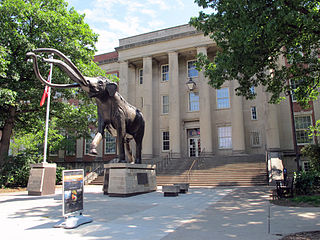
The University of Nebraska State Museum, also known as Morrill Hall, founded in 1871, is a natural history museum featuring Nebraska biodiversity, paleontology, and cultural diversity, located on the University of Nebraska–Lincoln City Campus near the corner of 14th and Vine Streets in Lincoln, Nebraska, United States. The museum houses Mueller Planetarium, a hands-on science discovery center, and the Elephant Hall, where visitors can see the world's largest articulated fossil mammoth among the collection of fossil elephants. Also featured are interactive paleontology exhibits, a dinosaur gallery, ancient life and evolution exhibits, wildlife dioramas, gems and minerals, American Indian and African exhibits, and a temporary exhibit gallery featuring rotating displays on diverse topics including photography, quilts and fine arts.

The Museum of Natural Sciences of Belgium is a museum dedicated to natural history, located in Brussels, Belgium. The museum is a part of the Royal Belgian Institute of Natural Sciences. Its most important pieces are 30 fossilised Iguanodon skeletons, which were discovered in 1878 in Bernissart, Belgium.
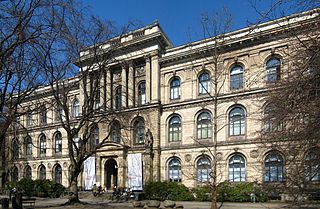
The Natural History Museum is a natural history museum located in Berlin, Germany. It exhibits a vast range of specimens from various segments of natural history and in such domain it is one of three major museums in Germany alongside Naturmuseum Senckenberg in Frankfurt and Museum Koenig in Bonn.

The Natural History Museum of Los Angeles County is the largest natural and historical museum in the western United States. Its collections include nearly 35 million specimens and artifacts and cover 4.5 billion years of history. This large collection comprises not only of specimens for exhibition, but also vast research collections housed on and offsite.

The Denver Museum of Nature & Science is a municipal natural history and science museum in Denver, Colorado. It is a resource for informal science education in the Rocky Mountain region. A variety of exhibitions, programs, and activities help museum visitors learn about the natural history of Colorado, Earth, and the universe. The 716,000-square-foot (66,519 m2) building houses more than one million objects in its collections including natural history and anthropological materials, as well as archival and library resources.

The Royal Alberta Museum (RAM) is a museum of human and natural history in Downtown Edmonton, Alberta, Canada, located north of City Hall. The museum is the largest in western Canada with more than 7,600 square metres (82,000 sq ft) exhibition space and 38,900 square metres (419,000 sq ft) in total.
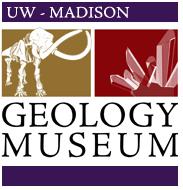
The UW–Madison Geology Museum (UWGM) is a geology and paleontology museum housed in Weeks Hall, in the southwest part of the University of Wisconsin–Madison campus. The museum's main undertakings are exhibits, outreach to the public, and research. It has the second highest attendance of any museum at the University of Wisconsin–Madison, exceeded only by the Chazen Museum of Art. The museum charges no admission.
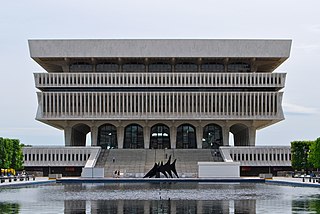
The New York State Museum is a research-backed institution in Albany, New York, United States. It is located on Madison Avenue, attached to the south side of the Empire State Plaza, facing onto the plaza and towards the New York State Capitol. The museum houses art, artifacts, and ecofacts that reflect New York’s cultural, natural, and geological development. Operated by the New York State Education Department's Office of Cultural Education, it is the oldest and largest state museum in the US. Formerly located in the State Education Building, the museum now occupies the first four floors of the Cultural Education Center, a ten-story, 1,500,000-square-foot (140,000 m2) building that also houses the New York State Archives and New York State Library.
The North Carolina Museum of Natural Sciences (NCMNS) is a museum in Raleigh, North Carolina. The museum is the oldest in the state.

The New Mexico Museum of Natural History and Science is a natural history and science museum in Albuquerque, New Mexico near Old Town Albuquerque. The Museum was founded in 1986. It operates as a public revenue facility of the New Mexico Department of Cultural Affairs.

The Museum of Evolution of Polish Academy of Sciences is the display area of the natural history museum in Warsaw, Poland. It is the public front of the Muzeum i Instytut Zoologii or Zoology Museum and the Instytut Paleobiologii or Paleobiology Institute. It is based at the Palace of Culture and Science.
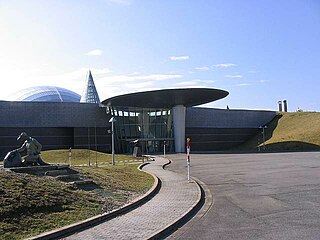
The Fukui Prefectural Dinosaur Museum, located in Katsuyama, Fukui, Japan, is one of the leading dinosaur museums in Asia that is renowned for its exhibits of fossil specimens of dinosaurs and paleontological research. It is sited in the Nagaoyama Park near the Kitadani Dinosaur Quarry that the Lower Cretaceous Kitadani Formation of the Tetori Group is cropped out and a large number of dinosaur remains including Fukuiraptor kitadaniensis and Fukuisaurus tetoriensis are found and excavated.

The Paleozoological Museum of China is a museum in Beijing, China. The same building also houses the Institute of Vertebrate Paleontology and Paleoanthropology of the Chinese Academy of Sciences. The museum contains exhibition halls with specimens aimed at the public, while the rest of the building is used for research purposes.
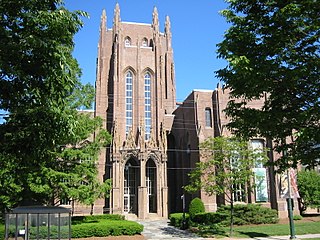
The Peabody Museum of Natural History at Yale University is one of the oldest, largest, and most prolific university natural history museums in the world. It was founded by the philanthropist George Peabody in 1866 at the behest of his nephew Othniel Charles Marsh, an early paleontologist. The museum is best known for the Great Hall of Dinosaurs, which includes a mounted juvenile Brontosaurus and the 110-foot-long (34 m) mural The Age of Reptiles. The museum also has permanent exhibits dedicated to human and mammal evolution; wildlife dioramas; Egyptian artifacts; local birds and minerals; and Native Americans of Connecticut.

Tianjin Natural History Museum is in Tianjin, China, and is located in No. 31 Youyi Road, in the Hexi District. It was founded in 1914 as the Hoangho Paiho Museum. The museum has three floors and spans an area of 12,000 square meters. Over 380,000 geological and biological specimens are currently held at the museum.



















